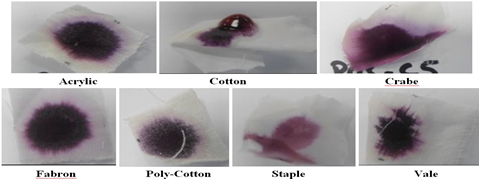Detection of Seminal Material on Hand-Washed Textile Evidence
Abstract
 Abstract Views: 0
Abstract Views: 0
Background. In sexual assault cases, a medical examination of the victim is often not conducted timely. This leaves the only chance to spot the ejaculate of the assailant on the victim’s clothing. Washing the victim’s clothes before the detection of semen in the forensic laboratory is a challenging task. Therefore, the current study aimed to examine the persistence of seminal material on seven different types of hand-washed fabrics using five laundry detergents.
Methods. The presence of seminal material on washed fabrics was determined using an alternate light source, acid phosphatase test, p30 test, and sperm head count.
Results. The study demonstrated that presumptive testing was not positive for most washed fabrics. A fairly large number of spermatozoa retained on a few fabrics even after 20 minutes of washing. The cotton yarn fabrics and tight weaving with warf and weft more than 100x100/inch could retain more sperms. The DNA was also isolated from sample and quantified using a Quantifiler Duo DNA quantification kit.
Conclusion. Good quality and quantity of human DNA were obtained from most of the washed fabrics, which could successfully generate the STR profile of the donor. The current study recommended using hand-washed textile items for forensic analysis in sexual assault cases.
Downloads
References
Beveridge T, Szkuta B, van Oorschot RA, Durdle A. The detection of blood, semen and saliva through fabrics: A pilot study. Forensic Sci Int. 2024;361:112153. https://doi.org/ 10.1016/j.forsciint.2024.112153
Tomaiuolo G, Fellico F, Preziosi V, et al. Post-liquefaction normospermic human semen behaves as a weak-gel viscoelastic fluid. Soft Matter. 2023;19(27):5039-5043. https://doi. org/10.1039/D3SM00443K
Malathi A, Iyer RP, Mohan R, Balakrishnan S. Impact of seasonal variations on semen parameters: A retrospective analysis of data from subjects attending a Tertiary Care Fertility Centre. J Hum Reprod Sci. 2023;16(2):114-120. https://doi.org/ 10.4103/jhrs.jhrs_20_23
Harbison S, Fleming R. Forensic body fluid identification: State of the art. Res Rep Forensic Med Sci. 2016;6:11-23. https://doi.org/10.2147/RRFMS .S57994
Daud SMSM, Sundram S. Identification of bloodstains on different fabrics after washing with commonly used detergent in Malaysia. J Manag Sci. 2019;17(1):9-9.
Mushtaq S, Rasool N, Firiyal S. Detection of dry bloodstains on different fabrics after washing with commercially available detergents. Aust J Forensic Sci. 2016;48(1):87-94. https://doi.org/10.1080/00450618.2015.1029971
Simon L, Ge SQ, Carrell DT. Sperm selection based on electrostatic charge. In: Spermatogenesis: Methods and Protocols. New York, NY: Springer; 2013:269-278. https://doi.org/10.1007 /978-1-62703-038-0_25
Stewart S, Willmott D, Murphy A, Phillips C. “I thought I’m better off just trying to put this behind me” – A contemporary approach to understanding why women decide not to report sexual violence. J Forensic Psychiatry Psychol. 2024;35(1):85-101. https://doi.org/10.1080/ 14789949.2023.2292103
Brayley-Morris H, Sorrell A, Revoir AP, et al. Persistence of DNA from laundered semen stains: Implications for child sex trafficking cases. Forensic Sci Int Genet. 2015;19:165-171. https://doi.org/10.1016/j.fsigen.2015.07.016
Nolan AN. The detection of spermatozoa on washed forensic exhibits. Murdoch University; 2016.
Gunn A. Essential Forensic Biology. Hoboken, NJ: John Wiley & Sons; 2019.
Önder E, Berkalp APDÖB. Weaving Technology II. 2017.
Jones S, Logan M, Davidson G, Murphy C, Strahorn P. Vaginal drainage of semen in underwear: A forensic study. Sci Justice. 2024;64(6):605-613. https://doi.org/ 10.1016/j.scijus.2024.09.003
Yudianto A, Wibowo A, Nuraini I, Aung HH, Kuntaman K. Acid Phosphatase and Zinc Tests Are Effective for Semen Examination and Identification to Prove Intercourse. Folia Medica Indonesiana. 2020;56(3):192-196. https://doi.org/ 10.20473/fmi.v56i3.24546
Redhead P, Brown MK. The acid phosphatase test two minute cut-off: An insufficient time to detect some semen stains. Sci Justice. 2013;53:187-191. https://doi.org/10.1016/j.scijus. 2012.09.004
Schlagetter TG, Glynn CL. The effect of fabric type and laundering conditions on the detection of semen stains. 2017. Available from: https://digitalcommons.newhaven.edu/forensicscience-facpubs/27
Noël S, Lagacé K, Raymond S, et al. Repeatedly washed semen stains: Optimal screening and sampling strategies for DNA analysis. Forensic Sci Int Genet. 2019;38:9-14. https:// doi.org/10.1016/j.fsigen.2018.10.002
Ajay S, Priyanka V, Hiren V, Priyanka M. Study on Acid Phosphatase Enzyme Activity in Semen Mixed with Various Body Fluids. J Forensic Sci Crim Investig. 2019;11(5):555-558.
Nolan A, Speers SJ, Murakami J, et al. A pilot study: The effects of repeat washing and fabric type on the detection of seminal fluid and spermatozoa. Forensic Sci Int. 2018;289:51-56. https://doi.org/10. 1016/j.forsciint.2018.05.021
Beckwith S, Murakami J, Chapman B. The persistence of semen on cotton fabric in various water environments. Aust J Forensic Sci. 2018:1-10. https://doi.org/10.1080/00450618.2018.1484164
Sakurada K, Watanabe K, Akutsu T. Current methods for body fluid identification related to sexual crime: Focusing on saliva, semen, and vaginal fluid. Diagnostics. 2020;10(9):693. https://doi.org/10.3390/diagnostics10090693
Noël S, Lagacé K, Rogic A, et al. DNA transfer during laundering may yield complete genetic profiles. Forensic Sci Int Genet. 2016;23:240-247. https:// doi.org/10.1016/j.fsigen.2016.05.004
Karadayi S, Moshfeghi E, Arasoglu T, et al. Evaluating the persistence of laundered semen stains on fabric using a forensic light source system, prostate-specific antigen semiquant test and DNA recovery-profiling. Med Sci Law. 2020. https://doi.org/ 10.1177/0025802419896935

Copyright (c) 2025 Asad Saeed, Nouman Rasool, Muhammad Ethisham Basel

This work is licensed under a Creative Commons Attribution 4.0 International License.
BSR follows an open-access publishing policy and full text of all published articles is available free, immediately upon publication of an issue. The journal’s contents are published and distributed under the terms of the Creative Commons Attribution 4.0 International (CC-BY 4.0) license. Thus, the work submitted to the journal implies that it is original, unpublished work of the authors (neither published previously nor accepted/under consideration for publication elsewhere). On acceptance of a manuscript for publication, a corresponding author on the behalf of all co-authors of the manuscript will sign and submit a completed the Copyright and Author Consent Form.









